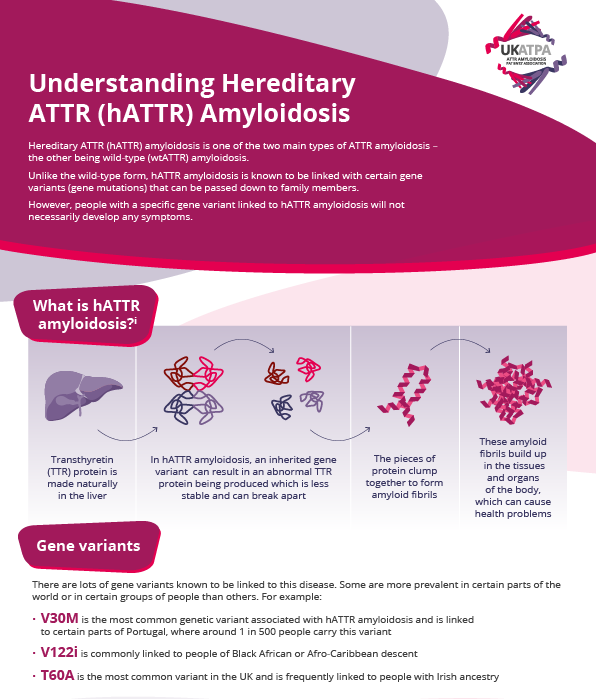Hereditary ATTR (hATTR) amyloidosis is different to wild-type ATTR amyloidosis as it is caused by an abnormal/altered gene in your DNA. It is an inherited condition and can therefore runs in families with the gene alteration potentially being passed down to children.
There is a 50% chance that the gene causing hATTR amyloidosis may be passed on to a child. However, it is important to note that those who carry the gene may never develop any symptoms.
Like wild-type ATTR amyloidosis, hATTR amyloidosis is usually a slow-progressing condition. However, it differs to wild-type because it is caused by a gene alteration in the TTR gene – the blueprint in your DNA for making the TTR protein.
In hATTR amyloidosis, the TTR protein is unstable and can break apart more easily. Pieces then clump together forming fibrils and eventually these become a deposit called amyloid.
As amyloid deposits build up in tissues and organs across the body, it affects how they work and can cause serious health problems.
hATTR amyloidosis can have a range of symptoms but it typically affects the nerves, heart, kidney and eyes.
Hereditary amyloidosis
Hereditary ATTR (hATTR) amyloidosis is different to wild-type ATTR amyloidosis as it is caused by an abnormal/altered gene in your DNA. It is an inherited condition and can therefore runs in families with the gene alteration potentially being passed down to children.
There is a 50% chance that the gene causing hATTR amyloidosis may be passed on to a child. However, it is important to note that those who carry the gene may never develop any symptoms.
Like wild-type ATTR amyloidosis, hATTR amyloidosis is usually a slow-progressing condition. However, it differs to wild-type because it is caused by a gene alteration in the TTR gene – the blueprint in your DNA for making the TTR protein.
In hATTR amyloidosis, the TTR protein is unstable and can break apart more easily. Pieces then clump together forming fibrils and eventually these become a deposit called amyloid.
As amyloid deposits build up in tissues and organs across the body, it affects how they work and can cause serious health problems.
hATTR amyloidosis can have a range of symptoms but it typically affects the nerves, heart, kidney and eyes.

Genetic alterations that cause hATTR amyloidosis
There are different forms of hATTR amyloidosis, with each caused by a slightly different alteration in the TTR gene.
Approximately 150 different variations have been observed so far and it is likely more will be discovered in the future. The most common is known as the V30M variant (or the TTR Val30Met mutation), although a variant called T60A accounts for the majority of cases in the UK & Ireland.
Which variant you have may be influenced by your family history. To learn more about the link between ethnicity, geography and disease, visit here.
Genetic alterations that cause hATTR amyloidosis
There are different forms of hATTR amyloidosis, with each caused by a slightly different alteration in the TTR gene.
Approximately 150 different variations have been observed so far and it is likely more will be discovered in the future. The most common is known as the V30M variant (or the TTR Val30Met mutation), although a variant called T60A accounts for the majority of cases in the UK & Ireland.
Which variant you have may be influenced by your family history. To learn more about the link between ethnicity, geography and disease, visit here.



Symptoms
Symptoms of hATTR amyloidosis may appear as early as age 20, or as late as age 80. Even if you are born with a gene alteration linked to hATTR amyloidosis, symptoms normally do not occur until adulthood.
Some symptoms to be aware of include:
- Peripheral neuropathy – this describes limb weakness and/or pain. It commonly is felt as a loss of sensation, particularly in the hands, fingers or other parts of the body.
- Autonomic neuropathy – this describes disruption to the bowel, bladder, blood pressure and sexual function
- Heart palpitations and abnormal heart rhythms
- Shortness of breath after mild exertion
- Chest pain (angina)
- Congestive heart failure
- Fatigue
- Dizziness
- Disrupted sleep
- Nausea
- Weight loss
- Leg swelling (also called oedema)
- Disease due to amyloid deposits in the:
- Eye
- Kidneys
- Thyroid gland
- Adrenal glands
- Blood vessels
Symptoms
Symptoms of hATTR amyloidosis may appear as early as age 20, or as late as age 80. Even if you are born with a gene alteration linked to hATTR amyloidosis, symptoms normally do not occur until adulthood.
Some symptoms to be aware of include:
- Peripheral neuropathy – this describes limb weakness and/or pain. It commonly is felt as a loss of sensation, particularly in the hands, fingers or other parts of the body.
- Autonomic neuropathy – this describes disruption to the bowel, bladder, blood pressure and sexual function
- Heart palpitations and abnormal heart rhythms
- Shortness of breath after mild exertion
- Chest pain (angina)
- Congestive heart failure
- Fatigue
- Dizziness
- Disrupted sleep
- Nausea
- Weight loss
- Leg swelling (also called oedema)
- Disease due to amyloid deposits in the:
- Eye
- Kidneys
- Thyroid gland
- Adrenal glands
- Blood vessels



Family links
hATTR amyloidosis is an inherited condition and within families the pattern of disease is usually quite similar, so knowing your family history is important.
Typically, the following factors are consistent within families:
- Age of onset – when you first experience symptoms
- How quickly the disease progresses
- How different parts of the body are affected (e.g. heart, eyes, hands etc)
In some families all affected members mainly experience neuropathy (disease of the nerves that causes numbness / pain); however, in other families, affected members may have both neuropathy and cardiac disease.
Family links
hATTR amyloidosis is an inherited condition and within families the pattern of disease is usually quite similar, so knowing your family history is important.
Typically, the following factors are consistent within families:
- Age of onset – when you first experience symptoms
- How quickly the disease progresses
- How different parts of the body are affected (e.g. heart, eyes, hands etc)
In some families all affected members mainly experience neuropathy (disease of the nerves that causes numbness / pain); however, in other families, affected members may have both neuropathy and cardiac disease.






Not all people carrying a genetic mutation develop the disease
Although all types of hATTR amyloidosis have the potential to cause very serious complications, some carriers of the TTR gene alteration may not show symptoms of the disease at all and will not go on to develop the disease. Equally, others may only be affected by minor health issues.
The risk that you or a family member will develop symptoms or serious complications if you are carrying a gene alteration linked to hATTR amyloidosis will vary depending on many factors. If you know the exact gene alteration you or a family member (e.g. a parent or sibling) has then it may help in assessing the risk of developing the disease. However, it is unlikely to be possible to be completely certain of whether or not symptoms will develop with current medical techniques.
Not all people carrying a genetic mutation develop the disease
Although all types of hATTR amyloidosis have the potential to cause very serious complications, some carriers of the TTR gene alteration may not show symptoms of the disease at all and will not go on to develop the disease. Equally, others may only be affected by minor health issues.
The risk that you or a family member will develop symptoms or serious complications if you are carrying a gene alteration linked to hATTR amyloidosis will vary depending on many factors. If you know the exact gene alteration you or a family member (e.g. a parent or sibling) has then it may help in assessing the risk of developing the disease. However, it is unlikely to be possible to be completely certain of whether or not symptoms will develop with current medical techniques.






Genetic testing in hATTR amyloidosis
It is possible to have a genetic test to see if you carry a gene that is associated with an increased risk of developing hATTR amyloidosis.
Having such a test is a very personal decision and there is no right or wrong answer as to whether you should or should not be tested. For some people it can help to know, for others it can cause distress and anxiety.
For those considering having a genetic test, we would always recommend discussing this first with your GP, making clear your motivation and any concerns you may have.
For those who then go on to have a genetic test, there may be the option to speak to a specialist genetic counsellor for free on the NHS who can help support you through the results.
If you would like to speak to someone who has gone through this, you can contact the team at UKATPA who will be happy to help.
If you would like a template letter to take to your GP explaining that you are considering a genetic test because you are aware a family member has hATTR amyloidosis, this can be found on the Resources section of our website.
Genetic testing in hATTR amyloidosis
It is possible to have a genetic test to see if you carry a gene that is associated with an increased risk of developing hATTR amyloidosis.
Having such a test is a very personal decision and there is no right or wrong answer as to whether you should or should not be tested. For some people it can help to know, for others it can cause distress and anxiety.
For those considering having a genetic test, we would always recommend discussing this first with your GP, making clear your motivation and any concerns you may have.
For those who then go on to have a genetic test, there may be the option to speak to a specialist genetic counsellor for free on the NHS who can help support you through the results.
If you would like to speak to someone who has gone through this, you can contact the team at Amyloidosis UK who will be happy to help.
If you would like a template letter to take to your GP explaining that you are considering a genetic test because you are aware a family member has hATTR amyloidosis, this can be found on the Resources section of our website.



Hereditary ATTR amyloidosis infographic
To learn more about hereditary ATTR amyloidosis, click here.
Hereditary ATTR amyloidosis infographic
To learn more about hereditary ATTR amyloidosis, click here.

